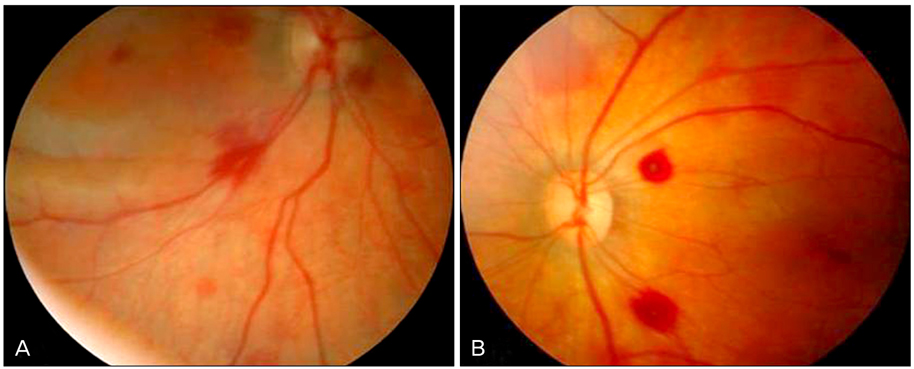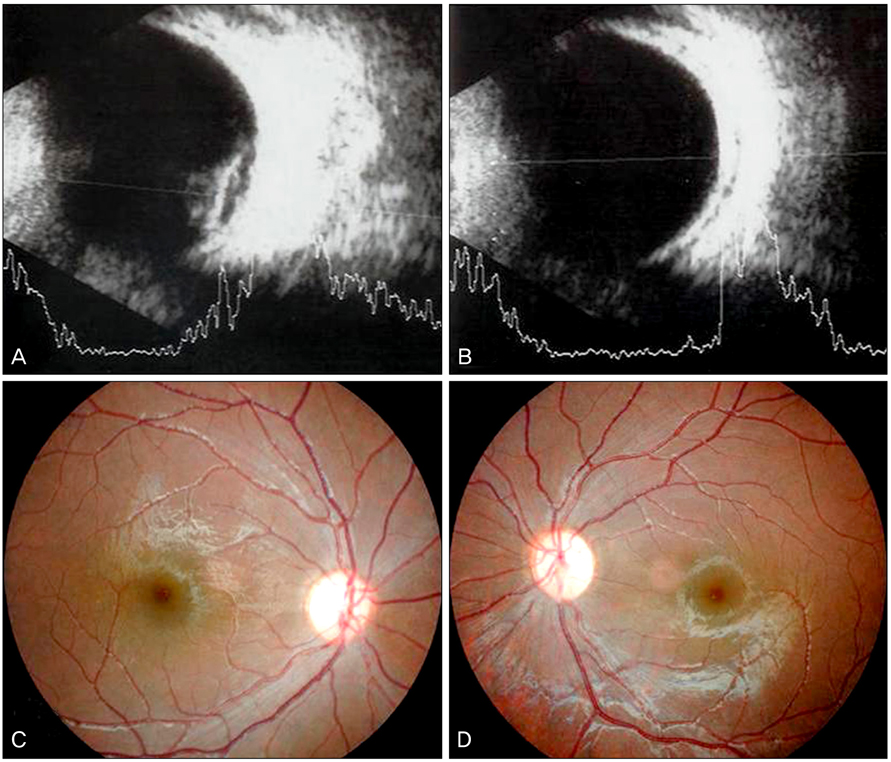Korean J Ophthalmol.
2011 Oct;25(5):311-316. 10.3341/kjo.2011.25.5.311.
Retinal Hemorrhage Associated with Perinatal Distress in Newborns
- Affiliations
-
- 1Department of Ophthalmology, Soonchunhyang University Hospital, Soonchunhyang University College of Medicine, Seoul, Korea.
- 2Department of Ophthalmology, Soonchunhyang University Cheonan Hospital, Soonchunhyang University College of Medicine, Cheonan, Korea. ophdrkim@schmc.ac.kr
- KMID: 1098632
- DOI: http://doi.org/10.3341/kjo.2011.25.5.311
Abstract
- PURPOSE
To describe the ophthalmoscopic features and natural history in a case series of eyes that developed intraocular hemorrhages associated with perinatal distress and to evaluate their clinical courses.
METHODS
A retrospective chart review of 289 neonates with a medical history of perinatal distress was conducted. Among these 289 patients (578 eyes), 29 eyes of 17 neonates were found to have had retinal hemorrhages or vitreous hemorrhages (VH). A comprehensive chart review, including details of fundoscopic findings and perinatal history, was conducted.
RESULTS
Intraocular hemorrhage was present in 5.5% of the patients. Most hemorrhages (82.7%) were intraretinal. In our population, 17% (n = 5) of hemorrhages resolved within two weeks, but 31% (n = 9) did not resolve even after four weeks. Most hemorrhages spontaneously resolved without any specific sequelae; however, one infant's dense unilateral VH persisted up to three months after birth. When the patient was seen again at 3.5 years of age, she had developed axial myopia and severe amblyopia of the involved eye.
CONCLUSIONS
In asphyxiated newborns, the possibility of intraocular hemorrhages should be considered. Long-standing, dense hemorrhages obscuring the macula may lead to severe vision deprivation amblyopia. Therefore, ophthalmic examination should be considered in neonates with perinatal distress, and close observation is necessary for hemorrhages that do not resolve in this amblyogenic age group.
MeSH Terms
Figure
Cited by 1 articles
-
Findings of Eye Screening Examinations with Wide-Field Digital Imaging System in Healthy Newborns
Se Young Park, So Young Kim
J Korean Ophthalmol Soc. 2015;56(10):1617-1623. doi: 10.3341/jkos.2015.56.10.1617.
Reference
-
1. Shaikh S, Fishman ML, Gaynon M, et al. Diffuse unilateral hemorrhagic retinopathy associated with accidental perinatal strangulation. A clinicopathologic report. Retina. 2001. 21:252–255.2. Emerson MV, Pieramici DJ, Stoessel KM, et al. Incidence and rate of disappearance of retinal hemorrhage in newborns. Ophthalmology. 2001. 108:36–39.3. Low JA. Intrapartum fetal asphyxia: definition, diagnosis, and classification. Am J Obstet Gynecol. 1997. 176:957–959.4. Gonzalez de Dios J. Definition of perinatal asphyxia in medical literature: the need of a consensus. Rev Neurol. 2002. 35:628–634.5. AIDS Clinical Trials Group (ACTG). Studies of ocular complications of AIDS Foscarnet-Ganciclovir Cytomegalovirus Retinitis Trial: 1. Rationale, design, and methods. Control Clin Trials. 1992. 13:22–39.6. Giles CL. Retinal hemorrhages in the newborn. Am J Ophthalmol. 1960. 49:1005–1011.7. Sezen F. Retinal haemorrhages in newborn infants. Br J Ophthalmol. 1971. 55:248–253.8. Kim KH, Rhee MG, Shin TY. Retinal hemorrhages in newborn infants. J Korean Ophthalmol Soc. 1980. 21:441–444.9. Hughes LA, May K, Talbot JF, Parsons MA. Incidence, distribution, and duration of birth-related retinal hemorrhages: a prospective study. J AAPOS. 2006. 10:102–106.10. Madan A, Hamrik S, Ferriero DM. Taeusch HW, Ballard RA, Gleason CA, editors. Central nervous system injury and neuroprotection. Avery's diseases of the newborn. 2005. 8th ed. Philadelphia: Elsevier Saunders;971–983.11. Geddes JF, Tasker RC, Hackshaw AK, et al. Dural haemorrhage in non-traumatic infant deaths: does it explain the bleeding in 'shaken baby syndrome'? Neuropathol Appl Neurobiol. 2003. 29:14–22.12. Ladjimi A, Zaouali S, Messaoud R, et al. Valsalva retinopathy induced by labour. Eur J Ophthalmol. 2002. 12:336–338.13. Smith DC, Kearns TP, Sayre GP. Preretinal and optic nerve-sheath hemorrhage: pathologic and experimental aspects in subarachnoid hemorrhage. Trans Am Acad Ophthalmol Otolaryngol. 1957. 61:201–211.14. Gardner H. Correlation between retinal abnormalities and intracranial abnormalities in the shaken baby syndrome. Am J Ophthalmol. 2003. 135:745.15. Shults WT, Swan KC. High altitude retinopathy in mountain climbers. Arch Ophthalmol. 1975. 93:404–408.16. Goetting MG, Sowa B. Retinal hemorrhage after cardiopulmonary resuscitation in children: an etiologic reevaluation. Pediatrics. 1990. 85:585–588.17. Van Ierland Y, de Beaufort AJ. Why does meconium cause meconium aspiration syndrome? Current concepts of MAS pathophysiology. Early Hum Dev. 2009. 85:617–620.18. Tyler DC, Murphy J, Cheney FW. Mechanical and chemical damage to lung tissue caused by meconium aspiration. Pediatrics. 1978. 62:454–459.19. Duane TD. Valsalva hemorrhagic retinopathy. Trans Am Ophthalmol Soc. 1972. 70:298–313.20. Barnes PD, Galaznik J, Gardner H, Shuman M. Infant acute life-threatening event: dysphagic choking versus nonaccidental injury. Semin Pediatr Neurol. 2010. 17:7–11.21. Spirn MJ, Lynn MJ, Hubbard GB 3rd. Vitreous hemorrhage in children. Ophthalmology. 2006. 113:848–852.22. Mohney BG. Axial myopia associated with dense vitreous hemorrhage of the neonate. J AAPOS. 2002. 6:348–353.23. Von Noorden GK, Lewis RA. Ocular axial length in unilateral congenital cataracts and blepharoptosis. Invest Ophthalmol Vis Sci. 1987. 28:750–752.24. Gee SS, Tabbara KF. Increase in ocular axial length in patients with corneal opacification. Ophthalmology. 1988. 95:1276–1278.25. Hoyt CS, Stone RD, Fromer C, Billson FA. Monocular axial myopia associated with neonatal eyelid closure in human infants. Am J Ophthalmol. 1981. 91:197–200.26. Miller-Meeks MJ, Bennett SR, Keech RV, Blodi CF. Myopia induced by vitreous hemorrhage. Am J Ophthalmol. 1990. 109:199–203.27. Ferrone PJ, de Juan E Jr. Vitreous hemorrhage in infants. Arch Ophthalmol. 1994. 112:1185–1189.28. Isenberg SJ. Isenberg SJ, editor. Acquired disorders of the infant eye, ocular trauma. The eye in infancy. 1994. St. Louis: Mosby;487.
- Full Text Links
- Actions
-
Cited
- CITED
-
- Close
- Share
- Similar articles
-
- Retinal Hemorrhage Incidence of Newborn with Intra-uterine Growth Retardation in Korea
- Neonatal Pneumothorax in Late Preterm and Full-Term Newborns with respiratory Distress: A Single-Center Experience
- Visual Disturbance Due to Delayed Retinal Hemorrhage after SAH 2 Cases Report
- Central Retinal Artery Occlusion Without Retrobular Hemorrhage after Retrobulbar Anesthesia
- Spontaneous Resolution of Sub-Retinal Pigment Epithelial Hemorrhage



